The debate rages on about what the best handgun is for women or the elderly. There are similar assumptions made in both cases. I understand these generalizations do not apply to all woman (obviously) nor all the elderly, so work with me on this.
The first assumption is that the new user will probably not practice very often and never be very comfortable or familiar with the manual of arms.
The second assumption is this new user has limited upper body and/or grip strength.
As you can see, both of these factors MIGHT apply to women and/or the elderly. So what do we recommend for self-defense?
I’d like to approach this conundrum with a factual look at both handgun varieties, regardless of shooter.
Manual of Arms
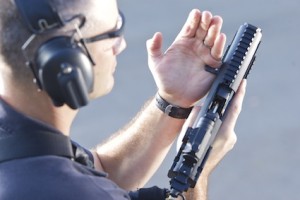 The manual of arms is actually much simpler for the wheel-gun shooter. Swing the cylinder out with the use of the cylinder release latch, load it up by dropping in rounds, swing it shut and you’re ready to fire. Pull the trigger. Simple.
The manual of arms is actually much simpler for the wheel-gun shooter. Swing the cylinder out with the use of the cylinder release latch, load it up by dropping in rounds, swing it shut and you’re ready to fire. Pull the trigger. Simple.
The semi-automatic is not so simple. The revolver has only one external control – the cylinder release. While some newer revolvers have the ridiculous key hole to lock the firearm, these are normally unobtrusive. The semi-automatic has up to five external controls with which the shooter must interact. The semi-automatic shooter must locate and depress the magazine release. This may be a simple button or a paddle beneath the trigger guard. Once the magazine drops free it must be loaded. This, as anyone helping a new shooter realizes, can be a challenge. The helpful want to introduce the “thumb” or other device to assist with the magazine load task, which often confuses the new shooter even more. <sigh>
The design of the slide lock lever/catch is to use upward pressure from the magazine follower to lock the slide to the rear when the magazine is exhausted. For this reason, the magazine must be smacked home in the grip. Simply sliding it in will often not allow it to catch securely.
Once the loaded magazine is inserted, the fun begins for those unfamiliar with the ease of a leveraged racking of the slide. Pushing with the firing hand opposite the pulling of the support hand is fairly easy once you get the hang of it – even for a monster recoil spring, as found in many of the mini-1911 carry guns. But don’t forget, racking the slide means letting go at the end of the rearward rack. The new shooter often feels the need to ride the slide back to rest, leading to other problems.
Now that we’ve got this beauty locked and loaded, as simple pull of the trigger lights the fire. However, unless we’re using a striker-fired gun, we can’t carry it like this. Now we must deal with the decocking lever, if available, or the thumb safety. There will be one – or the other – or both. <sigh>
Manual of arms goes to the revolver, hands down. It almost begs the question why anyone would deal with the complexity of the semi-auto in the first place! But Browning’s 1911 was our military sidearm for 75 years and was carried faithfully through half a dozen conflicts.
Maintenance
 Cleaning a revolver is more about dexterity than anything else. There are between five and eight chambers to be cleaned. The sprocket must be extended to clean around it and the mouth of each chamber. While the cylinder’s spinning in your hand, it can be a challenge. The outside of all the chambers must be cleaned too, as there is a lot of blow back from the cartridge firing. There’s not much more to it as the revolver’s action and internal parts are sealed from the blast of the cartridge.
Cleaning a revolver is more about dexterity than anything else. There are between five and eight chambers to be cleaned. The sprocket must be extended to clean around it and the mouth of each chamber. While the cylinder’s spinning in your hand, it can be a challenge. The outside of all the chambers must be cleaned too, as there is a lot of blow back from the cartridge firing. There’s not much more to it as the revolver’s action and internal parts are sealed from the blast of the cartridge.
Cleaning the semi-auto involves disassembling the firearm. Yikes! For many new shooters this is very scary. With most polymer guns, this amounts to about five parts though, so it’s not as intimidating once they are shown. However, the fact remains, the gun is being taken apart and has to be put together properly or it becomes a paperweight. And we need to note that the blast from the cartridge goes all over the inside of the gun. The inner workings are NOT protected from the shot blast.
Maintenance, I’m afraid, again, goes to the revolver. At what point does the semi-auto begin to gain some ground??
Shooting
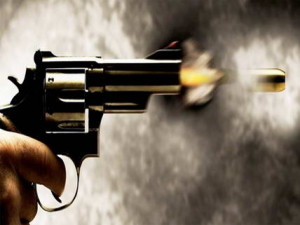 The revolver has a small number of rounds, limited, as it turns out, by the width of the cartridge and how many can fit around a small circle. The norm is 5 or 6 center fire cartridges. The semi-automatic can hold up to 17 rounds in the magazine inside the handgun grip. That’s a big differentiator. The semi-auto has nearly triple the number of rounds of the revolver. If the cylinder timing gets messed up through mishandling or damage, the revolver simply won’t fire. If there is a high primer that isn’t sitting flush with the head of the cartridge, it can impede the turning of the cylinder. If a round fails to extract from the cylinder, sliding under the star extractor, it’s a royal pain to get it out. Pocket knives are often deployed. Regardless of how to fix the problem, you are not shooting the revolver. You are not in the fight. Time to find a backup…
The revolver has a small number of rounds, limited, as it turns out, by the width of the cartridge and how many can fit around a small circle. The norm is 5 or 6 center fire cartridges. The semi-automatic can hold up to 17 rounds in the magazine inside the handgun grip. That’s a big differentiator. The semi-auto has nearly triple the number of rounds of the revolver. If the cylinder timing gets messed up through mishandling or damage, the revolver simply won’t fire. If there is a high primer that isn’t sitting flush with the head of the cartridge, it can impede the turning of the cylinder. If a round fails to extract from the cylinder, sliding under the star extractor, it’s a royal pain to get it out. Pocket knives are often deployed. Regardless of how to fix the problem, you are not shooting the revolver. You are not in the fight. Time to find a backup…
The mechanics of the semi-auto may malfunction. This may be due to the firearm, the ammunition or the shooter. Quite frankly, it’s statistically most often the shooter. 🙁 There are misfeeds, stove-pipes, double-feeds, failure-to-feed, and failures-to-extract. Remedial action is necessary for all these problems. However, the answer is normally a simple racking of the slide, perhaps after removing the magazine. In most cases, you’re back in the fight in under 5 seconds.
In summary, revolvers don’t often fail, but when they do, it’s catastrophic. Semi-autos may fail more often (I would argue that I own nearly two dozen semi-autos that have never, ever, had a malfunction) but are resolved in seconds. So in this case, even though the semi-auto is more complex, it more often than not holds more rounds than the revolver. Malfunctions, while perhaps more prevalent in the semi-auto are simple and fast to resolve (when trained) whereas the revolver is probably going to require tools.
Recoil
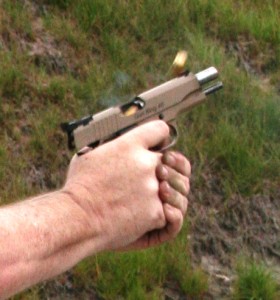 The final consideration is the actual firing of the handgun. Since the semi-auto uses some of the ignition gases to operate the firearm, the recoil is lessened. The revolver, on the other hand, pushes the entire firing impulse into the shooter’s hand. By definition, the semi-auto has less recoil than the revolver. Unless you’re firing powder-puff loads, the semi-auto can fire faster and with less recoil than the revolver. In a self-defense situation, that’s what I want my wife shooting… repeatedly, until the threat is removed.
The final consideration is the actual firing of the handgun. Since the semi-auto uses some of the ignition gases to operate the firearm, the recoil is lessened. The revolver, on the other hand, pushes the entire firing impulse into the shooter’s hand. By definition, the semi-auto has less recoil than the revolver. Unless you’re firing powder-puff loads, the semi-auto can fire faster and with less recoil than the revolver. In a self-defense situation, that’s what I want my wife shooting… repeatedly, until the threat is removed.
So let’s boil all this down.
- The Manual of Arms and Maintenance is much simpler on a Revolver.
- Recoil is easier and Malfunctions are more easily resolved on the Semi-Auto.
So it looks like a tie, 2 to 2. Not surprising, if you think through history.
The first cartridge-based firearm was the Smith & Wesson Model 3 in 1870, later refined by US Army Major George Schofield in 1875. Colt’s Peacemaker, Single-Action Army pistol was adopted in 1873. Folks, that’s nearly 150 years of revolver history. It works, and darn-it, it works well. Failures are very rare, giving the revolver an edge in the scoring.
On the other hand, Browning’s venerable Colt 1911 and FN Hi-Power have been adopted by more armies around the world than any other firearm in history. The most reproduced and tweaked handgun in the world is a semi-automatic that has been in constant use for over 100 years. Nearly every gun company makes a 1911 variant. While GLOCK’s ever-reproducible polymer copy of the Browning Hi-Power’s internals has breathed new life into many firearm manufacturers and birthed new ones too. One could argue that the maintenance issue has been proven to be less of an issue for the semi-automatic, especially with GLOCK’s proven reliability with virtually no care, edging the scores the other way.
So what’s the answer?? Take it from JoeGLOCK:
The BEST firearm for ANY shooter is first, one with which they are comfortable shooting safely and accurately. This means the gun fits their hand and they understand and can perform the manual of arms effortlessly.
Second, it’s a firearm the shooter can use effectively with the training commitment to which they have agreed/subscribed. I believe this is the reason most husbands recommend revolvers for their wives’ first handgun. It’s not a chauvinistic call, rather they may have concluded that their spouse will not train long enough or frequently enough to learn and become proficient with a semi-auto. They could be right…
My philosophy is to take as much time as necessary to ensure the shooter is familiar with both revolvers and semi-autos. I ensure they learn to leverage both hands when racking the slide. I provide them amply opportunity to handle, manipulate and fire both revolvers and semi-autos of all sizes and makes. Then I simply ask them which firearm is their choice. Some ladies choose the 1911 and some ladies choose a revolvers, while some ladies choose a polymer semi-auto. But all the ladies are confident, accurate shooters when we’re done. Quite frankly, I think they’re surprised that JoeGLOCK doesn’t automatically recommend a GLOCK. 🙂
Firearms are like shoes. Every shoe is not a good fit for every foot. Every shoe is not a good fit for every social event. Some shoes need more maintenance than others. Some people need more shoes than you think they should. 🙂
Today I think I’ll wear a BedStu retro sneaker in tan leather with off-white laces… and a Smith & Wesson revolver in a cool brown leather OWB holster.

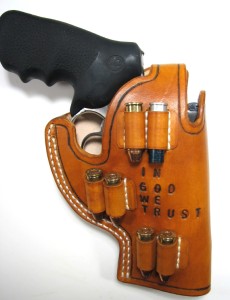 Should be a great day!
Should be a great day!
See you at the range.
JoeGLOCK
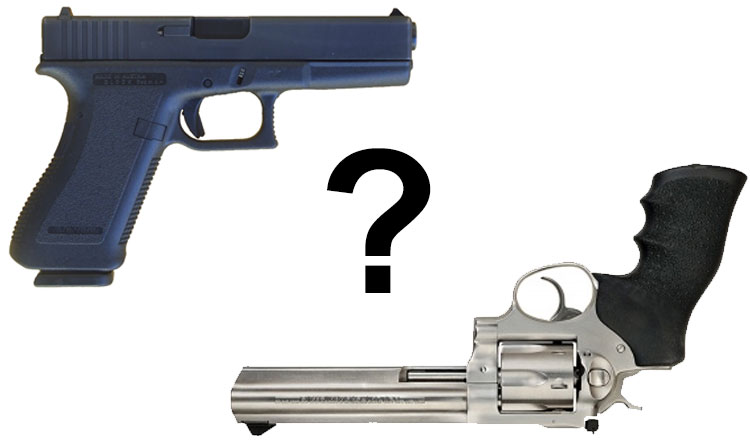
Great blog! And I love your humor!